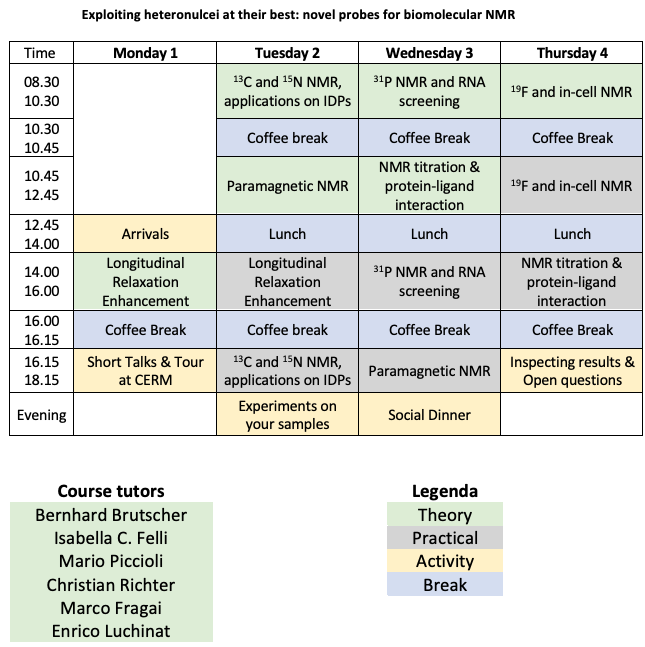 Instruct
Instruct Instruct Partner
Instruct PartnerThis advanced NMR course, organized in the frame of the ITACA.SB project, is designed to introduce participants to key concepts in the direct detection of heteronuclei (13C, 15N, 19F, 31P) with an overview on the wide range of application of this technique to the characterization of biomolecules, highlighting both the advantages and challenges of heteronuclear direct detection techniques.

Since the early days of solution-state biomolecular NMR, ¹H has been the most commonly observed nuclear spin. However, in recent years, several other nuclear spins have gained popularity and are now widely exploited for the study of biomolecules.
In particular, ¹³C direct detected experiments have become increasingly common, especially for the study of Intrinsically Disordered Proteins (IDPs) and multidomain proteins. ¹³C direct detection offers several advantages over ¹H direct detection, particularly when applied to IDPs. For example, ¹³C direct detection provides superior chemical shift dispersion compared to ¹H direct detection, a critical aspect when studying IDPs. Additionally, the non-exchangeable nature of ¹³C nuclei presents a significant advantage: when using ¹HN direct detection under near-physiological conditions, many peaks may not be observed due to fast exchange with water protons, resulting in line broadening beyond detection. In contrast, ¹³C nuclei are not subject to such exchange. In the area of IDPs, ¹⁵N direct detection is also gaining attention, and its potential is likely to be explored in the future.
Another highly useful NMR-active nucleus is ¹⁹F, since it is nearly 100% naturally abundant, it is very sensitive due to its high gyromagnetic ratio close the one of 1H, and it has a wide chemical shift range. ¹⁹F can be incorporated into proteins through modified amino acids and is also present in many ligands. It finds important applications in in-cell NMR, where ligand signals, encoding 19F, can be monitored upon binding to proteins in a cellular environment. Additionally, ¹⁹F direct detection is widely used in ligand-based NMR screening, a method that has become increasingly popular in drug discovery for generating high-quality hits. Its high sensitivity to protein binding makes it particularly well-suited for fragment screening, allowing the detection and quantification of very weak affinity ligands.
Finally, ³¹P represents another valuable NMR probe, naturally present in all nucleic acids. Direct observation of ³¹P nuclei allows the study of complex biomolecules, such as nucleic acids, in a particularly clean manner, for example by exploiting ³J couplings between phosphorus atoms and sugar protons, which provide dihedral angular restraints needed for structure calculation. Moreover, phosphorylation of specific amino acids, an important biological phenomenon, can also be investigated through NMR. In this context, ³¹P direct detection provides a clear and focused signal, enabling detailed analysis of these interactions. Furthermore, phosphorus-containing compounds are often used as ligands for proteins. Direct observation of the ³¹P nuclear spin once again enables an unprecedentedly clean view of the interaction from the ligand’s perspective, offering deeper insight into the binding process.
During this training course, that will be held at the Magnetic Resonance Center (CERM) in Sesto Fiorentino, participants will have the opportunity to attend talks on these topics, as well as participate in hands-on practical sessions. The latter are designed to provide direct experience with the tools and methods discussed, thereby deepening participants’ understanding and boosting their confidence in applying the knowledge in their own research projects.
The program also includes a session where the participants can acquire NMR experiments on their own samples guided by some of the instructors.
Moreover, several events where attendees can interact with instructors to discuss and share experiences are scheduled.

Find out more about the course and register here

ITACA.SB – “Potentiating the Italian Capacity for Structural Biology Services in Instruct-ERIC (Project no. IR0000009) within the call MUR 3264/2021 PNRR M4/C2/L3.1.1, funded by the European Union – Next Generation EU